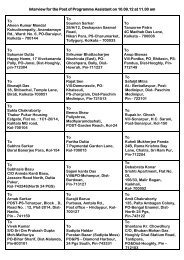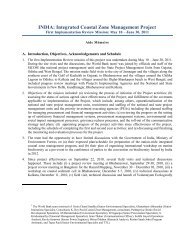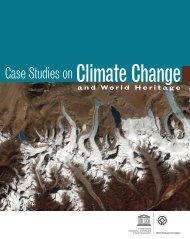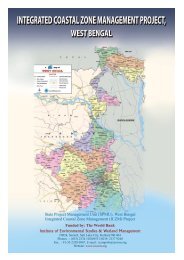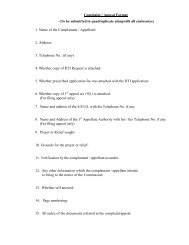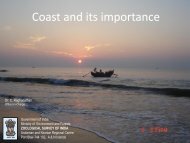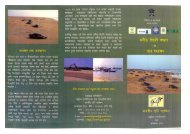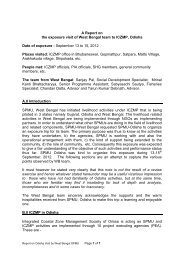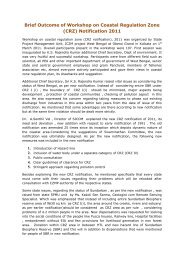Cyclone and Storm Surge - Iczmpwb.org
Cyclone and Storm Surge - Iczmpwb.org
Cyclone and Storm Surge - Iczmpwb.org
Create successful ePaper yourself
Turn your PDF publications into a flip-book with our unique Google optimized e-Paper software.
3.4<br />
these merchants may have been to some extent responsible for Charnock's choice of the site. By<br />
1696, when a rebellion broke out in the nearby district of Burdwan, the Mughal provincial<br />
administration had become friendly to the growing settlement. The servants of the company, who<br />
asked for permission to fortify their trading post, or factory, were given permission in general terms to<br />
defend themselves. The rebels were easily crushed by the Mughal government, but the settlers'<br />
defensive structure of brick <strong>and</strong> mud remained <strong>and</strong> in 1700 came to be known as Fort William. In<br />
1698 the English obtained letters patent that granted them the privilege of purchasing the zamindari<br />
right (the right of revenue collection; in effect, the ownership) of the three villages.<br />
Although Job Charnock initiated the installation of the Kuthighat on the river, it was his son who<br />
brought the Zemindary rights of the fledgling city, six years after the death of his father. In 1757, the<br />
area was 5076 Bighas <strong>and</strong> 18 3/4 Katthas. The area was bounded by the Chitpur Creek on the north,<br />
present day Lalbazar <strong>and</strong> the Chittaranjan Avenuae on the east, the Maidan <strong>and</strong> the Fort William on<br />
the south <strong>and</strong> the Hooghly river on the west. In 1794, Lord Cornwallis first defined the boundaries of<br />
the city. However it was in 1840, when for the first time the city limits were legally determined. These<br />
were the Marhatta ditch on the north, Circular road on the east, <strong>and</strong> the Lower Circular road,<br />
Kidderpur bridge, the Tolly's Nala up to the Hooghly river, which of course formed the boundary. In<br />
1840, the city limits were extended to include Entally, Bebiapukur, Ballyganj, Bhowanipur <strong>and</strong><br />
northern part of Tollyganj. In this way the city went on to exp<strong>and</strong> through inclusion of fresh suburban<br />
areas by stages in 1931, 1951 <strong>and</strong> 1984. Present area of the city is 187.33 sq. km. (72.33 sq miles).<br />
It may be noted that the Salt Lake area has now been brought under a separate municipality, called<br />
the Bidhan Nagar Municipality. The increase in population with time can be gauged from the Table 7:<br />
Table 3-1. Year wise Area <strong>and</strong> Population of Kolkata<br />
Year Area of the city Population Source <strong>and</strong> authorities<br />
1698 5076 bighas <strong>and</strong> 18 3/4 cottah<br />
(1861 acres)<br />
Wilson, Early, Annals I. p 286<br />
1746 5472 bighas <strong>and</strong> 1/2 cottah Holwell, Tracts, 3rd. Edition, p 209<br />
1762 6057 bighas <strong>and</strong> 13 cottahs Long, selections, no. 581<br />
1794 4997 acres/ 20.31 sq. km. A.K. Ray, A Short History of Calcutta<br />
l821 -do- 1,79,917 Assesor's estimate<br />
1831 -do- 1,87,081 Captain Steele's estimate<br />
1837 -do- 2,29,714 Captain Birch's estimate






